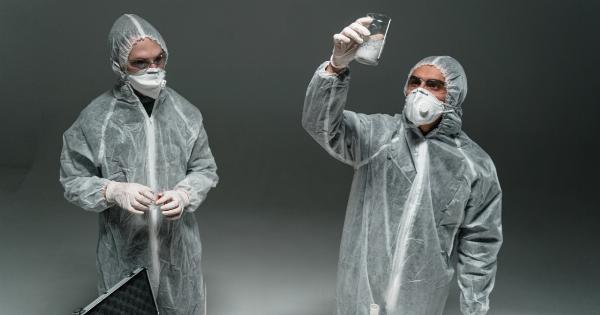In recent times, the world has been grappling with the outbreak of a new virus known as kronitovirus. This novel virus has caused widespread panic and concern, leading to various precautionary measures being taken by governments and individuals alike.
One such measure that has gained prominence is the use of masks. In this article, we will delve into the details of the kronitovirus and explore the role and significance of masks in combating its spread.
Understanding the Kronitovirus
The kronitovirus, also scientifically referred to as KRV, is a highly infectious respiratory virus that was first discovered in [insert location] in [insert year].
It belongs to the family of viruses that are known to cause severe acute respiratory syndrome, similar to the previously encountered SARS and MERS outbreaks. The kronitovirus is primarily transmitted through respiratory droplets when an infected person coughs, sneezes, or talks in close proximity to others.
Signs and Symptoms
Similar to other respiratory infections, the kronitovirus primarily affects the respiratory system. Common symptoms include fever, cough, and difficulty in breathing.
In severe cases, it can lead to pneumonia, acute respiratory distress syndrome (ARDS), organ failure, and even death. Although anyone can contract the virus, individuals with pre-existing medical conditions and older adults are more susceptible to developing severe illness.
Precautionary Measures
Given the highly contagious nature of the kronitovirus, it is crucial to adopt certain precautionary measures to minimize its spread:.
1. Wearing Masks
Masks play a vital role in preventing the transmission of kronitovirus. The virus primarily spreads through droplets expelled from an infected person’s respiratory system.
Masks act as a barrier by trapping these droplets and preventing them from entering the air and reaching other individuals. Hence, it is advisable for individuals to wear masks, particularly in crowded places or when social distancing is not feasible.
2. Choosing the Right Type of Mask
Not all masks are equally effective in preventing the transmission of the kronitovirus. The Centers for Disease Control and Prevention (CDC) recommends the use of non-medical fabric masks, commonly referred to as cloth masks, for the general public.
These masks are easily accessible, washable, and reusable. Medical-grade masks, such as N95 respirators, should be reserved for healthcare workers and individuals at high risk of exposure.
3. Proper Mask Usage
Simply wearing a mask is not sufficient; it is essential to ensure its proper usage. This involves:.
– Covering both the nose and mouth completely.
– Avoiding touching the mask while wearing it.
– Regularly washing fabric masks with soap and water or detergent.
– Replacing disposable masks when they become damp or damaged.
4. Social Distancing
In addition to wearing masks, maintaining a safe distance from others is crucial in preventing the spread of kronitovirus.
The World Health Organization (WHO) recommends maintaining at least a 1-meter distance from others, especially if they are coughing, sneezing, or not wearing a mask.
5. Hand Hygiene
Practicing good hand hygiene is crucial in reducing the risk of contracting the kronitovirus.
This involves regular handwashing with soap and water for at least 20 seconds or using an alcohol-based hand sanitizer when soap and water are not readily available.
The Importance of Masks in Kronitovirus Prevention
Masks have become a symbol of the fight against the kronitovirus. They offer a vital layer of protection not only to the wearer but also to those around them.
By trapping respiratory droplets, masks significantly reduce the number of infectious particles released into the environment. This, in turn, lowers the chances of transmission and helps in curbing the spread of the virus.
Challenges and Misconceptions
While masks have proven effective in preventing the transmission of kronitovirus, there are several challenges and misconceptions associated with their usage:.
1. Shortage of Masks
One of the initial challenges faced during the kronitovirus outbreak was the shortage of masks, particularly medical-grade masks.
The surge in demand, coupled with disruptions in the global supply chain, led to insufficient availability of masks worldwide. To overcome this, various initiatives were taken to promote the use of cloth masks, which offer a viable alternative.
2. Inconsistent mask usage
Despite the increasing awareness about the importance of masks, there are instances of inconsistent mask usage. Some individuals may not wear masks consistently or fail to adhere to proper mask-wearing practices.
This can undermine the effectiveness of masks in preventing the spread of kronitovirus.
3. Misinformation and Misunderstandings
The widespread circulation of misinformation and misconceptions about mask usage has added to the challenges.
Some individuals believe that wearing masks can lead to decreased oxygen intake or increased carbon dioxide levels, which is not supported by scientific evidence. It is essential to rely on trusted sources of information and follow guidelines provided by reputable health organizations.
Conclusion
The kronitovirus continues to pose a significant threat to global health, and it requires collective efforts to minimize its spread. Masks are a crucial tool in combating the virus and protecting oneself and others from infection.
By wearing masks appropriately, choosing the right type, and adhering to recommended guidelines, we can collectively contribute to curbing the transmission of the kronitovirus and safeguarding public health.































